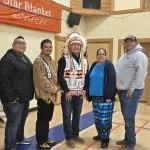
Reconciliation includes the return of sacred and historical items to First Nations
Repatriation – or the act of returning something to its origin – sounds simple but it can be complicated that’s where Portia Lafond can help.
She has experience with the Smithsonian Institute in Washington, DC and knows what the museum has and has helped communities start the repatriation process.
“I have a pretty great passion for repatriation,” said Lafond. “And I’ve always been interested in art and museums. Since I was young I wanted to explore that world.”
Over the past year, many Saskatchewan First Nations have successfully lobbied to have their sacred, ceremonial and historically significant items returned. Some items have been in personal collections while some are secured in places like the Smithsonian Institution.
Lafond, an Indigenous Studies graduate student at the University of Saskatchewan, and member of Muskeg Lake Cree Nation, gained invaluable insight into the United States largest and most important institutions for the preservation and study of natural and cultural history.
After visiting the Smithsonian Institution’s National Museum of the American Indian (NMAI) as an undergrad, Lafond said she became obsessed with the idea of getting an internship with the Smithsonian.
“I was extremely excited when I got that news, it was a dream come true for me,” she said.
This past summer Lafond interned in Washington, DC, at the NMAI – the only Canadian to do so, and one of only five Indigenous students to be selected for an internship.
As part of her role, she reviewed and helped produce teaching materials, conducted tours, shared how to properly teach Native American history, and helped organize an education summit.
Most importantly, Lafond took a very illuminating look at the NMAI’s own repatriation department.
“I built a relationship with some of the folks that worked there because they knew I was interested in their repatriation protocol,” she said. “I noticed a lot of items were labelled from Saskatchewan. That’s when my interest was piqued.”
Lafond was able to help itemize the collection and was able to look through every piece labelled under ‘Saskatchewan’.
“I don’t think many communities in Canada are aware of how many items the Smithsonian has,” said Lafond. “I looked through the descriptions to see how I could reach out to a community and explain the situation.”
She connected with Floyd Favel and Milton Tootoosis of Poundmaker First Nation, who have been active in their own repatriation projects, to let them know the museum held several artifacts from the First Nation. Unfortunately, the process for them, or any First Nation wishing to repatriate items from the Smithsonian, is lengthy.
“I think (the NMAI) said it would be three to five years to get these items,” said Lafond. “It’s one of the things I had an issue with. It’s already a hard process to reach out and it’s just lengthy. Some Elders are getting older and don’t have time to sit there and wait five years.”
Lafond also said the repatriation process is very colonial – not only is there a lot of paperwork, but the Smithsonian requires proof of proper storage facilities, such as air conditioned space, in order to have items returned.
“Indigenous folk have been fostering these items for millennia,” said Lafond. “I would think they would know how to take care of these cultural items.”
She’s not the only one who the same belief.
“[Favel] was saying many of these items have a life cycle, they’re not supposed to be held in collections for hundreds of years, they’re supposed to be in the community, amongst the people.” said Lafond.
The current political climate in the United States is also impacting the repatriation process.
Currently all 21 Smithsonian museums across the United States have temporarily closed due to loss of operating funds a direct result of government shutdown, which means a loss of public access, and delays for inquiring First Nations to begin their own repatriation process.
In the meantime, Lafond suggested interested First Nations visit the NMAI website and search to see if anything comes up in its artifact catalogue. But even this can be a tricky process because many items are not attributed to a specific First Nation but are simply labelled as ‘Plains Cree, Saskatchewan’.
In the long run it’s still worth the effort.
“The good thing is, they have a great process (for helping communities repatriate items),” said Lafond. “They’ll pay for your community to come down there. They have some items that are fake, so Elders and cultural folk have to come verify them.”
Once the items are verified they belong to that First Nation, the NMAI will eventually pay for shipping to have the items returned.
Despite the lengthy process, Lafond sees great value in First Nations in Saskatchewan starting their own repatriation journey.
“Returning these items back to community is a sacred process, it’s like taking the power and narrative back,” said Lafond. “I want to help nations advocate for them to get these items back. There should be a sense of urgency. And I do think there’s a sense of urgency to repatriate now more than ever.”

